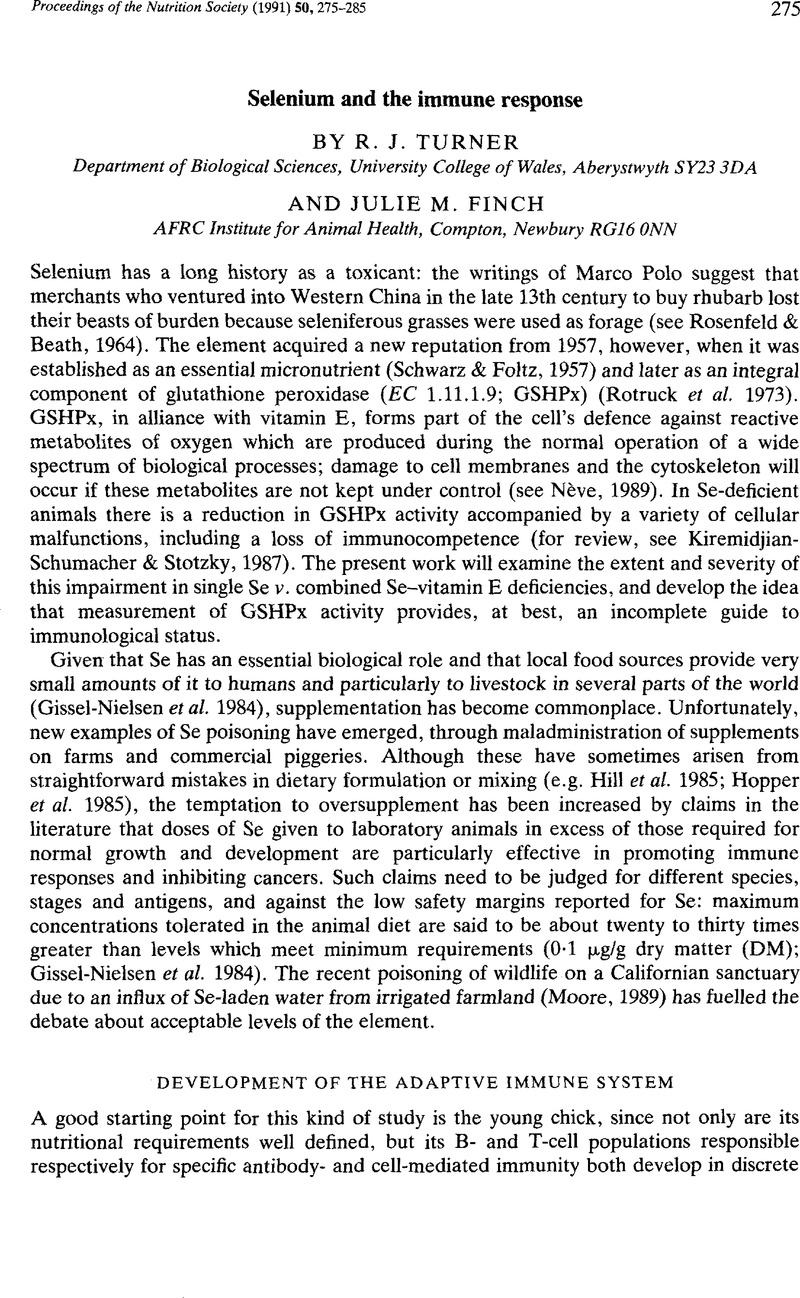Crossref Citations
This article has been cited by the following publications. This list is generated based on data provided by Crossref.
Arthur, John R.
and
Beckett, Geoffrey J.
1994.
Symposium 2 Newer aspects of micronutrients in at risk groups.
Proceedings of the Nutrition Society,
Vol. 53,
Issue. 3,
p.
615.
Gropper, S S
Chaung, H C
Bernstein, L E
Trahms, C
Rarback, S
and
Weese, S J
1995.
Immune status of children with phenylketonuria..
Journal of the American College of Nutrition,
Vol. 14,
Issue. 3,
p.
264.
Taylor, Ethan Will
1995.
Selenium and cellular immunity.
Biological Trace Element Research,
Vol. 49,
Issue. 2-3,
p.
85.
Christensen, Merrill J.
Cammack, Paul M.
and
Wray, Christian D.
1995.
Tissue specificity of selenoprotein gene expression in rats.
The Journal of Nutritional Biochemistry,
Vol. 6,
Issue. 7,
p.
367.
Reilly, Conor
1996.
Selenium in Food and Health.
p.
86.
Reilly, Conor
1996.
Selenium in Food and Health.
p.
133.
Borella, Paola
Bargellini, Annalisa
and
Incerti Medici, Cristina
1996.
Chemical form of selenium greatly affects metal uptake and responses by cultured human lymphocytes.
Biological Trace Element Research,
Vol. 51,
Issue. 1,
p.
43.
Reilly, Conor
1996.
Selenium in Food and Health.
p.
180.
Wen, Hong Y.
Davis, Randall L.
Shi, Bing
Chen, Jau-Jiin
Chen, Lugen
Boylan, Mallory
and
Spallholz, Julian E.
1997.
Bioavailability of selenium from veal, chicken, beef, pork, lamb, flounder, tuna, selenomethionine, and sodium selenite assessed in selenium-deficient rats.
Biological Trace Element Research,
Vol. 58,
Issue. 1-2,
p.
43.
Maher, W.
Deaker, M.
Jolley, D.
Krikowa, F.
and
Roberts, B.
1997.
Selenium Occurrence, Distribution and Speciation in the CockleAnadara trapezia and the MulletMugil cephalus.
Applied Organometallic Chemistry,
Vol. 11,
Issue. 4,
p.
313.
Reilly, Conor
1998.
Selenium: A new entrant into the functional food arena.
Trends in Food Science & Technology,
Vol. 9,
Issue. 3,
p.
114.
Combs, Gerald F.
and
Gray, William P.
1998.
Chemopreventive Agents.
Pharmacology & Therapeutics,
Vol. 79,
Issue. 3,
p.
179.
Zhang, W.
Ramanathan, C. S.
Nadimpalli, R. G.
Bhat, A. A.
Cox, A. G.
and
Taylor, E. W.
1999.
Selenium-dependent glutathione peroxidase modules encoded by RNA viruses.
Biological Trace Element Research,
Vol. 70,
Issue. 2,
p.
97.
Crews, Helen
2000.
Advances in Isotope Methods for the Analysis of Trace Elements in Man.
Vol. 20004586,
Issue. ,
p.
129.
Gupta, Umesh C.
and
Gupta, Subhas C.
2000.
Selenium in soils and crops, its deficiencies in livestock and humans: Implications for management.
Communications in Soil Science and Plant Analysis,
Vol. 31,
Issue. 11-14,
p.
1791.
Taylor, Ethan Will
Cox, Arthur G.
Zhao, Lijun
Ruzicka, Jan A.
Bhat, Ajita A.
Zhang, Weiqing
Nadimpalli, Ram Gopal
and
Dean, Roger G.
2000.
Nutrition, HIV, and Drug Abuse: The Molecular Basis of a Unique Role for Selenium.
JAIDS Journal of Acquired Immune Deficiency Syndromes,
Vol. 25,
Issue. ,
p.
S53.
Taylor, Ethan Will
Cox, Arthur G.
Zhao, Lijun
Ruzicka, Jan A.
Bhat, Ajita A.
Zhang, Weiqing
Nadimpalli, Ram Gopal
and
Dean, Roger G.
2000.
Nutrition, HIV, and Drug Abuse: The Molecular Basis of a Unique Role for Selenium.
Journal of Acquired Immune Deficiency Syndromes,
p.
S53.
Darlow, Brian A.
Winterbourn, Christine C.
Inder, Terrie E.
Graham, Patrick J.
Harding, Jane E.
Weston, Philip J.
Austin, Nicola C.
Elder, Dawn E.
Mogridge, Nina
Buss, I.Hendrikje
and
Sluis, Karl B.
2000.
The effect of selenium supplementation on outcome in very low birth weight infants: A randomized controlled trial.
The Journal of Pediatrics,
Vol. 136,
Issue. 4,
p.
473.
Grace, ND
Ankenbauer-Perkins, K
Alexander, AM
and
Marchant, RM
2001.
Relationship between blood selenium concentration or glutathione peroxidase activity, and milk selenium concentrations in New Zealand dairy cows.
New Zealand Veterinary Journal,
Vol. 49,
Issue. 1,
p.
24.
de Jong, Nynke
Gibson, Rosalind S.
Thomson, Christine D.
Ferguson, Elaine L.
Green, Timothy J.
Horwath, Caroline C.
and
McKenzie, Joanne E.
2001.
Selenium and Zinc Status Are Suboptimal in a Sample of Older New Zealand Women in a Community-Based Study.
The Journal of Nutrition,
Vol. 131,
Issue. 10,
p.
2677.



